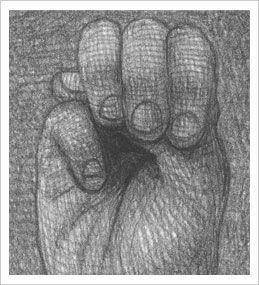The History of Deaf Culture and Sign Language
by Carol Padden and Tom Humphries.

American Sign Language, or ASL, is one of the most widely used sign languages in the world. There are an estimated 200- to 300,000 signers of ASL in the United States and Canada and many more who have learned it as a second language. ASL is not universal, meaning that it is not understood by signers of other sign languages around the world. No one knows how many different sign languages there are; a recent survey of all documented human languages lists 130 sign languages, which include Brazilian Sign Language, Japanese Sign Language, Portuguese Sign Language, French Canadian Sign Language, among others.
Where spoken languages use the voice and movement of the mouth to communicate, signers use their hands and their face and bodies to convey precise meaning. One handshape is like one consonant; the English words bat, rat, cat all differ only with the first consonant. Likewise, the signs BLACK and SUMMER are almost identical except for a different handshape.
In Wonderstruck, Ben learns to fingerspell English words. Fingerspelling is not the same as signing, but it is a useful way to include English words. In the same way that speakers of English borrow Spanish or French words for names and places, signers use fingerspelling when they want to represent an English word such as someone’s name or to identify a place. Signers might say “my name is….” and then they fingerspell their name, letter by letter.
ASL traces its history to 1814 when the first school for deaf children was founded in Hartford, Connecticut. ASL was created partly from French Sign Language which is even older, having its origins in Paris sometime around 1790. This means that ASL is likely about 300 or more years old. But fingerspelling is even older. There are charts showing fingerspelled handshapes in books published as early as 1620. These books describe how Spanish monks used fingerspelling to teach their deaf students to read and write.
Every sign language exists in a community of signers with a long history. ASL’s history parallels that of schools for deaf children in the United States and Canada. Today deaf children attend different types of schools, not only special schools for deaf children but public schools as well, along with hearing children. Maybe you have seen deaf students in your school with a sign language interpreter? Today, ASL is taught in high schools, in colleges and universities. An ASL class may even be available in your school.
Deaf communities are made up of deaf people and ASL signers (who may be hearing) and they can sometimes be very large and active communities. In some places, the deaf community has a long history of social and cultural activity including clubs, sports, theater in sign, and services to support the needs of Deaf people. Indeed, there may be a whole other world of deaf people for you to discover in your own community. You can see deaf actors on television, on the web and especially on YouTube where deaf people post videos in ASL. You can find old stories reflecting the history of deaf people and their culture on DVDs or on the web. In many of the same places, you can find modern adaptations of ASL in the form of poetry, narratives, and creative use of signing. Like all human languages, ASL is alive and always changing to meet the needs of communicating in the modern world. Whether language is in speech or sign, human beings seem to have a powerful ability to find ways to communicate and to identify closely with their language. Think about how valuable your language is to you. This is how deaf people feel about ASL.
Links:Carol Padden is professor of Communication and Associate Dean in the Division of Social Sciences at University of California, San Diego. She has written numerous academic and popular articles about sign languages and deaf communities around the world, and about fingerspelling. She is also co-author of several textbooks on learning American Sign Language. She was recently named a MacArthur Foundation Fellow in recognition of creativity and innovation in her research.
Tom Humphries is Associate Professor and Vice Chair of the Department of Education Studies at the University of California, San Diego. He is also Associate Professor in the Department of Communication. He is author with Carol Padden of two popular American Sign Language textbooks, A Basic Course in American Sign Language and Learning American Sign Language and two books on the culture of Deaf people, Deaf in America, and Inside Deaf Culture. His work has focused on designing new ways to train teachers of deaf children and to transform teaching practices used in the classroom.